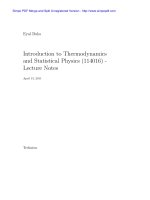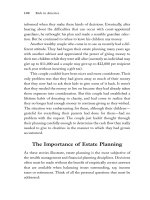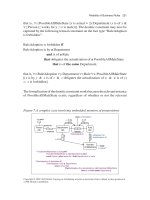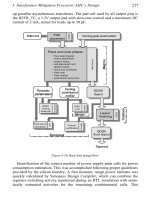Introduction to Thermodynamics and Statistical Physics phần 9 pptx
Bạn đang xem bản rút gọn của tài liệu. Xem và tải ngay bản đầy đủ của tài liệu tại đây (266.41 KB, 17 trang )
4.1. Classical Hamiltonian
H = m ˙q
2
−
m ˙q
2
2
+ V (q)
=
p
2
2m
+ V (q) .
(4.9)
Hamilton-Ja cobi equations (4.7) and (4.8) read
˙q =
p
m
(4.10)
˙p = −
∂V
∂q
. (4.11)
The second equation, which can be rewritten as
m¨q = −
∂V
∂q
, (4.12)
expresses Newton’s second law.
4.1.3 Example
L
C
L
C
Consider a capacitor having capacitance C connected in parallel to an
inductor h aving inductance L.Letq be the charge stored in the c apacitor.
The kinetic en ergy in this case T = L ˙q
2
/2 is the energy stored in the inductor,
and the potential energy V = q
2
/2C is t he energy stored in the capacitor.
The canonical conjugate momentum is given by [see Eq. (4.3)] p = L ˙q,and
the Hamiltonian (4.6) is given by
H =
p
2
2L
+
q
2
2C
. (4.13)
Hamilton-Ja cobi equations (4.7) and (4.8) read
˙q =
p
L
(4.14)
˙p = −
q
C
. (4.15)
The second equation, which can be rewritten as
L¨q +
q
C
=0, (4.16)
expresses the requiremen t that the voltage across the capacitor is the same
as the one across the inductor.
Eyal Buks Thermodynamics and Statistical Physics 129
Chapter 4. Classical Limit of Statistical Mechanics
4.2 Density Function
Consider a classical system in thermal equilibrium. The density function
ρ (¯q, ¯p) is the probability distribution to find the system in the poin t (¯q, ¯p).
The following theorem is given without a proof. Let H (¯q, ¯p) be an Hamilto-
nian of a system, and assume that H has the following form
H =
d
X
i=1
A
i
p
2
i
+ V (¯q) , (4.17)
where A
i
are constants. Then in the classical limit, namely in the limit where
Plank’s constant approaches zero h → 0, the density function is given by
ρ (¯q, ¯p)=N exp (−βH (¯q, ¯p)) , (4.18)
where
N =
1
R
d¯q
R
d¯p exp (−βH (¯q, ¯p))
(4.19)
is a normalization c onstant, β =1/τ,andτ is the temperature. The notation
R
d¯q indicates integration over all coordinates, namely
R
d¯q =
R
dq
1
R
dq
1
·
·
R
dq
d
, and similarly
R
d¯p =
R
dp
1
R
dp
1
· ·
R
dp
d
.
Let A (¯q, ¯p) be a variable which depends on the coordinates ¯q and their
canonical conjugate momentum variables ¯p. Using the above theorem the
average value of A can be calculates as:
hA (¯q, ¯p)i =
Z
d¯q
Z
d¯pA(¯q, ¯p) ρ (¯q, ¯p)
=
R
d¯q
R
d¯pA(¯q, ¯p)exp(−βH (¯q, ¯p))
R
d¯q
R
d¯p exp (−βH (¯q, ¯p))
.
(4.20)
4.2.1 Equipartition Theorem
Assume that the Hamiltonian has the following form
H = B
i
q
2
i
+
˜
H , (4.21)
where B
i
is a constant and where
˜
H is independent of q
i
. Then the following
holds
B
i
q
2
i
®
=
τ
2
. (4.22)
Similarly, assume that the Hamiltonian has the following form
Eyal Buks Thermodynamics and Statistical Physics 130
4.2. Density Function
H = A
i
p
2
i
+
˜
H , (4.23)
where A
i
is a constant and where
˜
H is independent of p
i
. Then the following
holds
A
i
p
2
i
®
=
τ
2
. (4.24)
To prove the theorem for the firstcaseweuseEq.(4.20)
B
i
q
2
i
®
=
R
d¯q
R
d¯pB
i
q
2
i
exp (−βH (¯q, ¯p))
R
d¯q
R
d¯p exp (−βH (¯q, ¯p))
=
R
dq
i
B
i
q
2
i
exp
¡
−βB
i
q
2
i
¢
R
dq
i
exp (−βB
i
q
2
i
)
= −
∂
∂β
log
µ
Z
dq
i
exp
¡
−βB
i
q
2
i
¢
¶
= −
∂
∂β
log
µ
r
π
βB
i
¶
=
1
2β
.
(4.25)
The proof for the second case is similar.
4.2.2 Example
Here we calculate the average energy of an harmonic oscillator using both,
classical and quantum approac hes. Consider a particle having mass m in a
one dimensional para bolic potential given by V (q)=(1/2) kq
2
,wherek is
the spring constant. The kinetic energy is giv en by p
2
/2m,wherep is the
canonical momentum variable conjugate to q. The Hamiltonian is given by
H =
p
2
2m
+
kq
2
2
. (4.26)
In the classical limit the average energy of the system can be easily calculated
using the equipartition theorem
U = hHi = τ. (4.27)
In the quant um treatment the system has energy lev els given by
E
s
= s~ω,
where s =0, 1, 2, ,andwhereω =
p
k/m is the angular resonance fre-
quency. The partition function is given by
Eyal Buks Thermodynamics and Statistical Physics 131
Chapter 4. Classical Limit of Statistical Mechanics
Z =
∞
X
s=0
exp (−sβ~ω)=
1
1 − exp (−β~ω)
, (4.28)
thus the average energy U is given by
U = −
∂ log Z
∂β
=
~ω
e
β~ω
− 1
. (4.29)
Using the expansion
U = β
−1
+ O (β) , (4.30)
one finds that in the limit of high temperatures, namely when β~ω ¿ 1, the
quantum result [Eq. (4.30)] coincides with the classical limit [Eq. (4.27)].
4.3 Nyquist Noise
Here we employ the equipartition theorem in order to evaluate voltage noise
across a resistor. Consider the circuit shown in the figure belo w, which consists
of a capacitor having capacitance C, an inductor having inductance L,anda
resistor having resistance R, all s erially conn ected. The system is assumed to
be in thermal equilibrium at temperature τ.Tomodeltheeffect of thermal
fluctuations we add a fictitious voltage source, which produces a random
fluctuating voltage V (t). Let q (t) be the charge stored in the capacitor at
time t. The classical equation of motion, which is given by
q
C
+ L¨q + R ˙q = V (t) , (4.31)
represents Kirchhoff’s voltage law.
R
L
C
V(t)
~
R
L
C
V(t)
~
Fig. 4.1.
Eyal Buks Thermodynamics and Statistical Physics 132
4.3. Nyquist Noise
Consider a sampling of the fluctuating function q (t) in the time interval
(−T/2,T/2), namely
q
T
(t)=
½
q(t) −T/2 <t<T/2
0else
. (4.32)
The energy s tored in the capacitor is given by q
2
/2C. Using the equipartition
theorem one finds
q
2
®
2C
=
τ
2
, (4.33)
where
q
2
®
is obtained by averaging q
2
(t), namely
q
2
®
≡ lim
T →∞
1
T
Z
+∞
−∞
dtq
2
T
(t) . (4.34)
Introducing the Fourier transform:
q
T
(t)=
1
√
2π
Z
∞
−∞
dωq
T
(ω)e
−iωt
, (4.35)
one finds
q
2
®
= lim
T →∞
1
T
Z
+∞
−∞
dt
1
√
2π
Z
∞
−∞
dωq
T
(ω)e
−iωt
1
√
2π
Z
∞
−∞
dω
0
q
T
(ω
0
)e
−iω
0
t
=
1
2π
Z
∞
−∞
dωq
T
(ω)
Z
∞
−∞
dω
0
q
T
(ω
0
) lim
T →∞
1
T
Z
+∞
−∞
dte
−i
(
ω+ω
0
)
t
| {z }
2πδ(ω+ω
0
)
= lim
T →∞
1
T
Z
∞
−∞
dωq
T
(ω)q
T
(−ω) .
(4.36)
Moreover, using the fact that q(t)isrealonefinds
q
2
®
= lim
T →∞
1
T
Z
∞
−∞
dω |q
T
(ω)|
2
. (4.37)
In terms of the po wer spectrum S
q
(ω)ofq (t), which is defined as
S
q
(ω) = lim
T →∞
1
T
|q
T
(ω)|
2
, (4.38)
one finds
q
2
®
=
Z
∞
−∞
dωS
q
(ω) . (4.39)
Eyal Buks Thermodynamics and Statistical Physics 133
Chapter 4. Classical Limit of Statistical Mechanics
Taking the Fourier transform of Eq. (4.31) yields
µ
1
C
− iωR − Lω
2
¶
q(ω)=V ( ω) , (4.40)
where V (ω) is the Fourier transform of V (t), namely
V (t)=
1
√
2π
Z
∞
−∞
dωV(ω)e
−iωt
. (4.41)
In terms of the resonance frequency
ω
0
=
r
1
LC
, (4 .42)
one has
£
L
¡
ω
2
0
− ω
2
¢
− iωR
¤
q(ω)=V (ω) . (4.43)
Taking the absolute value squared yields
S
q
(ω)=
S
V
(ω)
L
2
(ω
2
0
− ω
2
)
2
+ ω
2
R
2
, (4.44)
where S
V
(ω) is the power spectrum of V (t). Integrating the last result yields
Z
∞
−∞
dωS
q
(ω)=
Z
∞
−∞
dω
S
V
(ω)
L
2
(ω
2
0
− ω
2
)
2
+ ω
2
R
2
=
1
L
2
Z
∞
−∞
dω
S
V
(ω)
(ω
0
+ ω)
2
(ω
0
− ω)
2
+
ω
2
R
2
L
2
.
(4.45)
The integrand has a peak near ω
0
,havingawidth' R/2L. T he Qua lity
factor Q is defined as
ω
0
Q
=
R
2L
. (4.46)
Assuming S
V
(ω) is a smooth function ne ar ω
0
on the scale ω
0
/Q,andas-
suming Q À 1 yield
Eyal Buks Thermodynamics and Statistical Physics 134
4.3. Nyquist Noise
Z
∞
−∞
dω S
q
(ω) '
S
V
(ω
0
)
L
2
Z
∞
−∞
dω
(ω
0
+ ω)
2
(ω
0
− ω)
2
+
³
2ωω
0
Q
´
2
'
S
V
(ω
0
)
4ω
4
0
L
2
Z
∞
−∞
dω
³
ω
0
−ω
ω
0
´
2
+
³
1
Q
´
2
=
S
V
(ω
0
)
4ω
3
0
L
2
Z
∞
−∞
dx
x
2
+
³
1
Q
´
2
| {z }
πQ
=
S
V
(ω
0
)πQ
4ω
3
0
L
2
.
(4.47)
On the other hand, using Eqs. (4.33) and (4.39) one finds
Z
∞
−∞
dωS
q
(ω)=
q
2
®
= Cτ , (4.48)
therefore
S
V
(ω
0
)=
4Cω
3
0
L
2
πQ
τ, (4.49)
or using Eqs. (4.42) and (4.46)
S
V
(ω
0
)=
2Rτ
π
. (4.50)
Th us, Eq. (4.44) can be rewritten as
S
q
(ω)=
2Rτ
π
1
L
2
(ω
2
0
− ω
2
)
2
+ ω
2
R
2
. (4.51)
Note that the spectral density of V given by Eq. (4.50) is frequency in-
dependent. Consider a measurement of the fluctuating voltag e V (t)ina
frequency band having width ∆f.Usingtherelation
V
2
®
=
Z
∞
−∞
dωS
V
(ω) , (4.52)
one finds that the variance in such a measurement
V
2
®
∆f
is given by
V
2
®
∆f
=4Rτ∆f . (4.53)
ThelastresultistheNyquist’snoiseformula.
Eyal Buks Thermodynamics and Statistical Physics 135
Chapter 4. Classical Limit of Statistical Mechanics
4.4 Problems Set 4
1. A gas at temperature τ emits a spectral line at wave lengt h λ
0
.The
width of the observed spectral line is broadened due to motion of the
molecules (this is called Doppler broadening). Show that the relation
between spectral line intensity I and wavelength is given by
I (λ) ∝ exp
"
−
mc
2
(λ − λ
0
)
2
2λ
2
0
τ
#
, (4.54)
where c is velocity of fight, and m is mass of a molecule.
2. The circuit seen in the figure below, which contains a resistor R,ca-
pacitor C, and an inductor L, is at thermal equilibrium at tempera-
ture τ. Calculate the average value
I
2
®
,whereI is the current in the
inductor.
RC LRC L
3. Consider a random real signal q(t)varyingintime.Letq
T
(t)beasam-
pling of the signal q(t) in the time interval (−T/2,T/2), namely
q
T
(t)=
½
q(t) −T/2 <t<T/2
0else
. (4.55)
The Fourier transform is giv en b y
q
T
(t)=
1
√
2π
Z
∞
−∞
dωq
T
(ω)e
−iωt
, (4.56)
and the power spectrum is given by
S
q
(ω) = lim
T →∞
1
T
|q
T
(ω)|
2
.
a) Show that
q
2
®
≡ lim
T →∞
1
T
Z
+∞
−∞
dtq
2
T
(t)=
Z
∞
−∞
dωS
q
(ω) . (4.57)
Eyal Buks Thermodynamics and Statistical Physics 136
4.4. Problems Set 4
b) Wiener-Khinchine Theorem - sho w that the correlation function
of the random signal q(t)isgivenby
hq (t) q (t + t
0
)i ≡ lim
T →∞
1
T
Z
+∞
−∞
dtq
T
(t) q
T
(t + t
0
)=
Z
∞
−∞
dωe
iωt
0
S
q
(ω) .
(4.58)
4. Consider a resonator made of a capacitor C, an inductor L,andaresistor
R connected in series, as was done in class. Let I (t) be the curren t in the
circuit. Using the results obtained in class calculate the spectral density
S
I
(ω)ofI at thermal equilibrium. Show that in the limit of high quality
factor, namely when
Q =
2
R
r
L
C
À 1 , (4.59)
your result is consistent with the equipartition theorem applied for the
energy stored in the inductor.
5. A classical system is described using a set of coordinates {q
1
,q
2
, , q
N
}
and the corresponding canonically conjugate variables {p
1
,p
2
, , p
N
}.
The Hamiltonian of the system is given by
H =
N
X
n=1
A
n
p
s
n
+ B
n
q
t
n
, (4.60)
where A
n
and B
n
are positive constants and s and t are even positive
integers. Show that t he average energy of the system in equilibrium at
temperature τ is given by
hUi = Nτ
µ
1
s
+
1
t
¶
, (4.61)
6. A sma ll hole of area A is made in the walls of a vessel of volume V con-
taining a classical ideal gas of N particles of mass M each in equilibrium
at temperature τ. Calculate the number of particles dN, which escape
through the opening during the infinitesimal time interval dt.
7. Consider an ideal gas of Fermions ha ving mass M andhavingnointernal
degrees of freedom at temperature τ. The velocity of a particle is denoted
as v =
q
v
2
x
+ v
2
y
+ v
2
z
. Calculate the quan t ity
hvi
¿
1
v
À
(the symbol hi denoted av eraging) in the:
a) classical limit (high temperatures).
Eyal Buks Thermodynamics and Statistical Physics 137
Chapter 4. Classical Limit of Statistical Mechanics
b) zero temperature.
8. Consider an ideal gas of N molecules, each of mass M, contained in a
cen tr ifuge of radius R and length L rotating with angular velocity ω
about its axis. Neglect the effect of grav ity. The system is in equilibrium
at temperature τ =1/β. Calculate the particle density n (r) as a function
of the radial distance from the axis r (where0≤ r ≤ R) .
9. Consider an ideal classical gas of p articles having mass M and having no
internal degrees of freedom at temperature τ.Letv =
q
v
2
x
+ v
2
y
+ v
2
z
.
be the velocity of a particle. Calculate
a) hvi
b)
p
hv
2
i
10. A mixture of t wo classical ideal gases, consisting of N
1
and N
2
particles
of mass M
1
and M
2
, respectively, is enclosed in a cylindrica l vessel of
heigh t h and area of bottom and top side S. The vessel is placed in a
gravitational field having acceleration g. The system is in thermal equi-
librium at temperature τ. Find the pressure exerted on the upper wall of
the cylinder.
4.5 Solutions Set 4
1. Let λ bethewavelengthmeasuredbyanobserver,andletλ
0
be the
wave length of the emitted light in the reference frame where the molecule
is at rest. Let v
x
be the velocity of the molecule in the direction of the
ligh t ray from the molecule to the observer. Due to Doppler effect
λ = λ
0
(1 + v
x
/c) . (4.62)
The probability distribution f (v
x
) is proportional to
f (v
x
) ∝ exp
µ
−
mv
2
x
2τ
¶
, (4.63)
thus using
v
x
=
c (λ − λ
0
)
λ
0
, (4.64)
the probability distribution I (λ) is proportional to
I (λ) ∝ exp
"
−
mc
2
(λ − λ
0
)
2
2λ
2
0
τ
#
. (4.65)
2. The energy s tored in the inductor is U
L
= LI
2
/2. Using the eq uipartition
theorem hU
L
i = τ/2, thus
I
2
®
=
τ
L
. (4.66)
Eyal Buks Thermodynamics and Statistical Physics 138
4.5. Solutions Set 4
3.
a)
q
2
®
= lim
T →∞
1
T
Z
+∞
−∞
dt
1
√
2π
Z
∞
−∞
dωq
T
(ω)e
−iωt
1
√
2π
Z
∞
−∞
dω
0
q
T
(ω
0
)e
−iω
0
t
=
1
2π
Z
∞
−∞
dωq
T
(ω)
Z
∞
−∞
dω
0
q
T
(ω
0
) lim
T →∞
1
T
Z
+∞
−∞
dte
−i
(
ω+ω
0
)
t
| {z }
2πδ(ω+ω
0
)
= lim
T →∞
1
T
Z
∞
−∞
dωq
T
(ω)q
T
(−ω) .
(4.67)
Since q(t) is real one has q
T
(−ω)=q
∗
T
(ω), th us
q
2
®
=
Z
∞
−∞
dωS
q
(ω) . (4.68)
b)
hq (t) q (t + t
0
)i ≡ lim
T →∞
1
T
Z
+∞
−∞
dtq
T
(t) q
T
(t + t
0
)
=
1
2π
lim
T →∞
1
T
Z
+∞
−∞
dt
Z
∞
−∞
dωq
T
(ω)e
−iωt
Z
∞
−∞
dω
0
q
T
(ω
0
)e
−iω
0
(
t+t
0
)
=
1
2π
lim
T →∞
1
T
Z
∞
−∞
dωe
−iω
0
t
0
q
T
(ω)
Z
∞
−∞
dω
0
q
T
(ω
0
)
Z
+∞
−∞
dte
−i
(
ω+ω
0
)
t
| {z }
2πδ(ω+ω
0
)
=lim
T →∞
1
T
Z
∞
−∞
dωe
iωt
0
q
T
(ω)q
T
(−ω)
=
Z
∞
−∞
dωe
iωt
0
S
f
(ω) .
(4.69)
4. Using I (ω)=−iωq (ω)and
q
2
®
= Cτ one finds for the case Q À 1
I
2
®
=
Z
∞
−∞
dωS
I
(ω) ' ω
2
0
Z
∞
−∞
dωS
q
(ω)=ω
2
0
q
2
®
=
τ
L
, (4.70)
in agreement with the equipartition t heorem for the e ne rg y stored in the
inductor LI
2
/2.
5. Calculate for example
Eyal Buks Thermodynamics and Statistical Physics 139
Chapter 4. Classical Limit of Statistical Mechanics
B
n
q
t
n
đ
=
R
B
n
q
t
n
exp (B
n
q
t
n
)dq
n
R
exp (B
n
q
t
xn
)dq
n
=
R
0
B
n
q
t
n
exp (B
n
q
t
n
)dq
n
R
0
exp (B
n
q
t
xn
)dq
n
=
d
d
log
Z
0
exp
Ă
B
n
q
t
n
Â
dq
n
.
(4.71)
where =1/. Changing int egration variab le
x = B
n
q
t
n
, (4.72)
dx = tB
n
q
t1
n
dq
n
, (4.73)
leads to
B
n
q
t
n
đ
=
d
d
log
ã
(B
n
)
1
t
t
1
Z
0
x
1
t
1
e
x
dx
á
=
t
. (4.74)
Thus
hUi =
N
X
n=1
hA
n
p
s
n
i +
B
n
q
t
n
đ
= N
à
1
s
+
1
t
ả
. (4.75)
6. Let f (v) be the probability distribution of velocity v of particles in the
gas. The vector u is expressed in spherical coordinates, where the z axis
is chosen in the direction of the normal outward direction
v = v (sin cos , sin sin , cos ) . (4.76)
By symmetry, f (v) is independen t of and .ThenumberdN is calcu-
lated by integrating o ver all possible values of the velocity of the leaving
particles (note that can be only in the range 0 /2)
dN =
Z
0
dv
Z
1
0
d(cos)
Z
2
0
dv
2
v (dt) A cos
N
V
f (v) . (4.77)
Note tha t v (dt) A cos represents the volume of a cylinder from which
particles of velocity v can escape during the time in terval dt.Sincef (v)
is normalized
1=
Z
0
dv
Z
1
0
d(cos)
Z
2
0
dv
2
f (v)=4
Z
0
dvv
2
f (v) , (4.78)
thus
dN
dt
=
NA
V
Z
0
dvv
2
vf (v)=
NAhvi
4V
. (4.79)
Eyal Buks Thermodynamics and Statistical Physics 140
4.5. Solutions Set 4
In the classical limit
f (v) ∝ exp
µ
−
Mv
2
2τ
¶
, (4.80)
th us, b y changing the integration variable
x =
Mv
2
2τ
(4.81)
one finds
hvi =
R
∞
0
dvv
3
exp
³
−
Mv
2
2τ
´
R
∞
0
dvv
2
exp
¡
−
Mv
2
2τ
¢
=
µ
2τ
M
¶
1/2
R
∞
0
dxx exp ( −x)
R
∞
0
dxx
1/2
exp (−x)
=
µ
8τ
πM
¶
1/2
,
(4.82)
and
dN
dt
=
NA
4V
µ
8τ
πM
¶
1/2
. (4.83)
7. The probability that an orbital having energy ε is occupied is given by
f
F
(ε)=
1
1+exp[(ε − µ) β]
, (4.84)
where β =1/τ and µ is the c hemical potential. The velocity v of such an
orbital is related to the energy ε by
ε =
Mv
2
2
. (4.85)
The 3D density of state per unit v olume is given by
g (ε)=
1
2π
2
µ
2M
~
2
¶
3/2
ε
1/2
. (4.86)
Thus
Eyal Buks Thermodynamics and Statistical Physics 141
Chapter 4. Classical Limit of Statistical Mechanics
hvi
¿
1
v
À
=
∞
R
0
dεg(ε) f
F
(ε) v
∞
R
0
dεg(ε) f
F
(ε)
∞
R
0
dεg(ε) f
F
(ε)
1
v
∞
R
0
dεg(ε) f
F
(ε)
=
µ
∞
R
0
dεεf
F
(ε)
¶µ
∞
R
0
dεf
F
(ε)
¶
µ
∞
R
0
dεε
1/2
f
F
(ε)
¶
2
.
(4.87)
a) In the classical limit
f
F
(ε) ∝ exp (−βε) , (4.88)
th us using the identities
∞
Z
0
dεε
n
exp (−βε)=Γ (n) β
−n
n
β
∞
Z
0
dε ex p (−βε)=
1
β
Γ (1) = 1
Γ
µ
1
2
¶
=
√
π
one finds
hvi
¿
1
v
À
=
µ
∞
R
0
dεεexp (−βε)
¶µ
∞
R
0
dε exp (−βε)
¶
µ
∞
R
0
dεε
1/2
exp (−βε)
¶
2
=
Γ (1) β
−1
1
β
1
β
³
Γ
¡
1
2
¢
β
−1/2
1
2β
´
2
=
4
π
.
(4.89)
b) Using the identit y
ε
F
Z
0
dεε
n
=
ε
n+1
F
n +1
Eyal Buks Thermodynamics and Statistical Physics 142
4.5. Solutions Set 4
one finds
hvi
¿
1
v
À
=
µ
ε
F
R
0
dεε
¶µ
ε
F
R
0
dε
¶
µ
ε
F
R
0
dεε
1/2
¶
2
.
=
1
2
ε
2
F
ε
F
³
2
3
ε
3
2
F
´
2
=
9
8
.
(4.90)
8. The effect of rotation is the same as an additional external field with
potential energy given by
U (r)=−
1
2
Mω
2
r
2
, (4 .91)
thus
n (r)=A exp [−βU (r)] = A ex p
µ
βMω
2
2
r
2
¶
, (4.92)
where the normalization constant A is found from the condition
N =2πL
Z
R
0
n (r) rdr
=2πLA
Z
R
0
exp
µ
βMω
2
2
r
2
¶
rdr
=
2πLA
βMω
2
·
exp
µ
βMω
2
2
R
2
¶
− 1
¸
,
(4.93)
thus
n (r)=
NβMω
2
2πL
h
exp
³
βMω
2
2
R
2
´
− 1
i
exp
µ
β
2
Mω
2
r
2
¶
. (4.94)
9. In the classical limit the probability distribution of the velocity vector v
satisfies
f (v) ∝ exp
µ
−
Mv
2
2τ
¶
, (4.95)
where v = |v|.
Eyal Buks Thermodynamics and Statistical Physics 143
Chapter 4. Classical Limit of Statistical Mechanics
a) By changing the integration variable
x =
Mv
2
2τ
(4.96)
one finds
hvi =
R
∞
0
dvv
3
exp
³
−
Mv
2
2τ
´
R
∞
0
dvv
2
exp
¡
−
Mv
2
2τ
¢
(4.97)
=
µ
2τ
M
¶
1/2
R
∞
0
dxx exp (−x)
R
∞
0
dxx
1/2
exp (−x)
=
µ
8τ
πM
¶
1/2
.
(4.98)
b) Similarly
v
2
®
=
R
∞
0
dvv
4
exp
³
−
Mv
2
2τ
´
R
∞
0
dvv
2
exp
¡
−
Mv
2
2τ
¢
=
2τ
M
R
∞
0
dxx
3/2
exp (−x)
R
∞
0
dxx
1/2
exp (−x)
=
2τ
M
3
2
,
(4.99)
thus
p
hv
2
i =
µ
3τ
M
¶
1/2
=
µ
3π
8
¶
1/2
hvi . (4.100)
10. For each gas the density is given by
n
l
(z)=n
l
(0) exp (−βM
l
gz) ,
where l ∈ {1, 2},0≤ z ≤ h and the normalization constant is found from
the requirement
S
h
Z
0
n (z)dz = N
l
, (4.101)
therefore
n
l
(0) =
N
l
S
h
R
0
exp (−βM
l
gz)dz
=
βM
l
gN
l
S (1 − e
−βM
l
gh
)
. (4.102)
Eyal Buks Thermodynamics and Statistical Physics 144
4.5. Solutions Set 4
Using the equation of state p = nτ,wheren = N/V is the density, one
finds that the pressure on the upper wall of the cylinder is given by
p =(n
1
(h)+n
2
(h)) τ
=
µ
M
1
N
1
exp (βM
1
gh) − 1
+
M
2
N
2
exp (βM
2
gh) − 1
¶
g
S
.
(4.103)
Eyal Buks Thermodynamics and Statistical Physics 145









